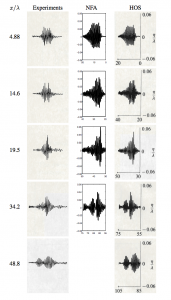The figure below shows fissioning of a wave packet using the High-Order Spectral (HOS) method and the Numerical Flow Analysis (NFA) code with comparisons to experiments. The experiments are reported in Su (1982). Details of the HOS simulation are available in Dommermuth and Yue (1987). Details of the NFA simulation are available in Dommermuth, Fu, Brucker, O’Shea, and Wyatt (2010). The paper is available at http://tinyurl.com/yaedzwqe.

Su (1982) studied experimentally the evolution of wave groups that had initially square envelopes. For wave steepnesses ranging from 0.09 to 0.28, he measured the free-surface elevation at eight stations down the tank. For wave steepnesses greater than 0.14, he observed intense two-dimensional breaking at distances between ten and twenty carrier wavelengths from the wavemaker. Fifteen to twenty-five wavelengths from the wavemaker, crescent-shaped breaking waves often developed, and from twenty to forty-five wavelengths away, two-dimensional spilling breaking was common. The initial packet has 5 waves.
NFA is a two-phase formulation with volume-of-fluid code interface tracking. NFA solves the full three- dimensional Navier-Stokes equations using an implicit sub-grid scale (SGS) model. NFA allows wave overturning and wave breaking. The results here show that NFA can accurately model subtle wave nonlinearities.
For the NFA simulation, a wave packet is generated using a surface stress. A fixed frame of reference is used. Unlike the HOS simulations, the NFA simulations allow breaking. For these NFA simulations, the breaking manifests itself as coaming at the crests of the waves at the front of the wave group. At about forty wavelengths from the wavemaker, we confirm the experimental observation that the wave group fissions into two packets. The NFA simulations are able to predict a weak wave nonlinearity that occurs over one hundred wave periods. The agreement between results of the numerical simulations and experimental measurements suggests that VOF simulations could be used to study the long-time evolution of a seaway complete with wave breaking.
References:
Dommermuth, D. G. and Yue, D. K. (1987) A high-order spectral method for the study of nonlinear gravity waves, J. Fluid Mech., vol. 187, 267–288.
Dommermuth, D. G., Fu, T. C., O’Shea, T. T., Brucker, K. A., and Wyatt, D. C. (2010) Numerical prediction of a seaway, Proceedings of the 28th Symposium on Naval Hydrodynamics, Pasadena, California, USA
Su, M. (1982) Evolution of groups of gravity waves with moderate to high steepness, Phys. Fluids, vol. 25, 2167–2174.
